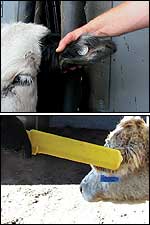Many industries are just beginning to develop standards and systems for using RFID. But a small percentage of ranchers have been using RFID for more than a decade— mainly to make it easier to gather data on their livestock—and the technology is fairly mature.
The RFID tags can be placed under the skin, in the reticulum—a secondary compartment in the cow’s stomach—or attached to the ear of an animal. Concern over the entry of tags into the food chain if not removed at the slaughterhouse has made the ear tag by far the most common way to tag cattle. Most of the ear tags used today have just a bar code or a serial number on them, but some also have an RFID transponder embedded in them. Ear tags are placed about 1.5 inches from the animal’s head (to avoid having it snagged on something and torn off).
The transponders in the tags typically operate at low frequency (125 to 134.2 kHz). The International Organization for Standardization (ISO) has established international standards for cattle tracking. ISO 11784 defines how data is structured on the tag, while ISO 11785 defines the “air interface”—the protocol that governs how transponders and RFID readers communicate.
The tags typically hold a unique ID number and nothing else. Information associated with the animal is stored in a database (there are some read-write tags in use that store more data on the tag). Fixed readers can be placed at the opening of a livestock restraining shoot, so cattle can be identified as they leave a corral or enter an abattoir. The read range is typically about 3 feet (1 meter). Farmers can also use handheld readers, which typically have a read range of less than 1 foot (0.31 meter).


